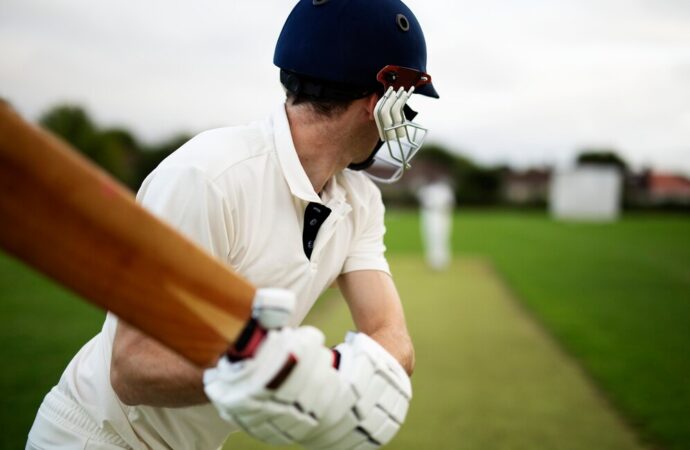People often say that cricket is the biggest religion in the world. It is a sport that often brings families together as they watch matches. Conversations about the latest cricket game are frequent at workplaces and social gatherings. Cricket is played between two teams. Each comprises eleven players. The game unfolds on a circular or
People often say that cricket is the biggest religion in the world. It is a sport that often brings families together as they watch matches. Conversations about the latest cricket game are frequent at workplaces and social gatherings.
Cricket is played between two teams. Each comprises eleven players. The game unfolds on a circular or oval-shaped field with a rectangular 22-yard-long pitch in the center. The primary objective of cricket is to accumulate more runs than the opposing team.
Below, you’ll find some fundamental rules of cricket. However, the game’s intricacies can vary depending on the format and the level of play.
Basic Cricket Rules
Over time, a comprehensive set of rules has evolved to govern cricket, some of which may appear bewildering to newcomers. However, grasping a few basic cricket rules can enable almost anyone to engage in and enjoy the game.
The umpires enforce cricket’s laws. Two umpires are stationed on the field during play. A third umpire, located off the field, often assists in making challenging decisions, particularly regarding catches and boundary calls, using television replays in professional cricket.
Each team comprises 11 players, including a wicketkeeper, specialized batsmen, bowlers, and all-rounders who excel in batting and bowling, such as cricketing legends like Ian Botham, Jacques Kallis, Gary Sobers, and Kapil Dev.
In front of each set of stumps, a chalk line or “crease” is marked to define the batsman’s territory. If the batsman stays within their crease or keeps their bat within it, they are protected from being “run out.”
The decision of which team bats first is determined by a coin toss, with the opposing team assuming the role of bowlers. Batsmen form pairs, each equipped with a bat, stationed at opposite ends of the wicket. Bowlers deliver one over at a time, attempting to dismiss the batsmen or get them “out.”
Dismissal of a batsman can occur through various means, with the most common including:
- Bowled – When the ball hits the stumps without the batsman defending it.
- Caught – If a batsman hits the ball, it’s caught by a fielding player before it touches the ground.
- Stumped – The wicketkeeper can “stump” a batsman if they step out of their crease, leaving no part of their body or bat behind, and the bails are removed with the ball.
- LBW (Leg Before Wicket) – If the ball would have hit the stumps but struck the batsman’s leg pad instead (various conditions apply).
- Run-out – Either batsmen can be ‘run-out’ if the ball hits the stumps towards which they are running before they are inside their crease.
Other rare methods of dismissal, such as hitting one’s stumps or handling the ball, should be fine for beginners.
The batting team aims to accumulate as many runs as possible before losing 10 of their 11 wickets, while the bowling team strives to minimize runs and secure dismissals.
The teams switch roles, with the bowling side taking their turn to bat and vice versa. This reversal occurs once in one-day “limited overs” games but may happen twice in international test match cricket.
Cricket demands exceptional skills, including concentration, hand-eye coordination, precision, resilience, and attributes like speed, strength, and agility. It provides a rigorous workout and, most importantly, is immensely enjoyable. This guide aims to help you maximize your enjoyment of the sport.
Basic Cricket Skills and Exercises
When your child embarks on their sports journey, it significantly enhances their enjoyment if they possess a foundational skill level and comprehension of the game. It enables greater participation and bolsters their confidence, fueling their motivation to remain active and continue playing. To excel as a cricket player, one must possess:
- Strong hand-eye coordination
- Proficiency in throwing and catching a ball
- Sound batting and bowling techniques
- The ability to sustain focus, sometimes over extended durations
In the following section, we will engage in exercises designed to develop skills in the first two areas. It’s important to understand that effective concentration is a skill that matures with time and practice.
Exercise 1 Batting: Hand-Eye Coordination and Batting Technique.
The late and legendary Don Bradman incorporated this daily exercise into his childhood routine, a practice that undoubtedly contributed to his exceptional skills.
First, position yourself approximately 4 meters away from a concrete wall and initiate the exercise by striking a tennis ball against it. As the ball rebounds, strike it once more.
Face the wall with your feet shoulder-width apart when executing the shot. Keep your bat lifted, poised for contact with the ball. Maintain your front elbow up, and strike through the ball to ensure it bounces once before making contact with the wall.
Challenge yourself to sustain a continuous sequence of hits, striving for as many hits as possible before your control falters. You can even turn this into a friendly competition with your friends to determine who can achieve the highest number of consecutive hits.
As you progress and seek greater difficulty, consider switching to a golf ball to enhance your skills.
Exercise 2 Fielding: Throwing and Catching
As the age-old suggests, ” Catches win matches underscores the significance of sharpening your hand-eye coordination for effective catching.
Here’s a drill to enhance this skill:
- Position two balls on the ground, approximately 3 meters before a wall.
- Begin by picking up the first ball, tossing it against the wall, clapping your hands, and then catching it with both hands as it rebounds.
- After the catch, place the ball back on the ground and swiftly run to a designated marker located 10 meters behind you from the wall.
- Upon reaching the marker, promptly return to the second ball.
- Grab the second ball, throw it at the wall, clap your hands, and focus on catching it with one hand.
- Set the second ball on the ground, dash back to the 10-meter marker, and then proceed to the first ball to repeat the process.
- Challenge yourself to increase your speed with each iteration, striving to complete as many cycles as possible without dropping the ball.
- Use your non-dominant hand to catch at the second ball station to improve your coordination.
This drill sharpens your catching abilities and encourages ambidexterity in the process.
Exercise 3: Bowling Technique
Mastering the proper cricket bowling technique can pose a challenge for beginners. Therefore, it’s crucial to commence with a gradual approach, focusing on perfecting the technique before worrying about the accuracy of your delivery. The “Rock and Bowl” drill is an excellent method for learners.
Here’s how to go about it:
- Position yourself sideways with the batsmen or wickets, with your dominant hand at the back.
- Hold the ball under your chin using both hands and turn your head to face the batsmen or target.
- Execute a smooth, consistent rocking motion, shifting your weight from the front foot to the back foot.
- As you rock backward, extend your back arm, and when you rock forward, allow your front arm to extend while pulling down. Simultaneously, let your back arm come over your head, releasing the ball toward the batsmen.
It’s essential to be patient and dedicated to practicing this technique until you feel comfortable. Additionally, observing your favorite bowlers to glean tips from their techniques can be highly beneficial.
Regularly practicing these three exercises will equip you with the foundational skills to participate in cricket matches and enjoy the game. Furthermore, beginner-level coaching camps are held throughout the globe during school holidays.


















Leave a Comment
Your email address will not be published. Required fields are marked with *